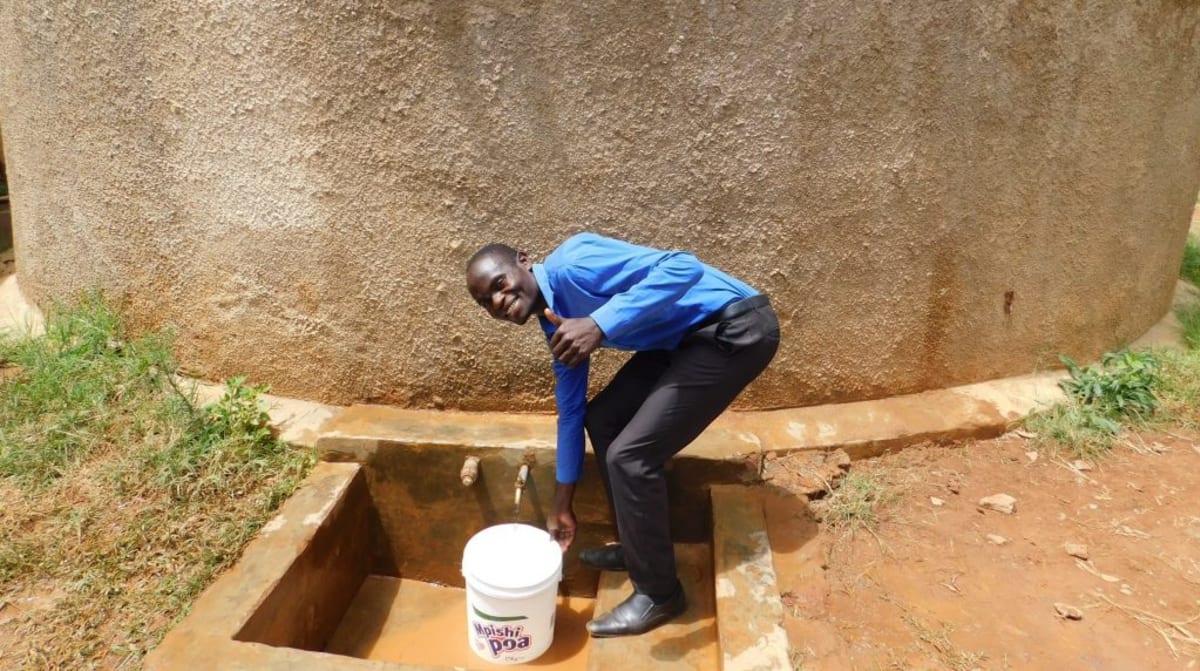St. Joseph Malimili Secondary School is a day school located in Kakamega, Kenya. Student enrollment is 485, 253 of which are boys and 232 of which are girls. The school employs 20 teachers and nine support staff.
A normal school day begins at 6am with morning study hall. At 6:40am, students break into groups to tackle their assigned cleaning chores, like sweeping and picking up litter. Morning classes stretch until an hour lunch break, after which students return for their afternoon classes that go until 5:30pm.
Fee payment is at a low, for many parents struggle to make a steady income. Many others also struggle with alcoholism. Since the school doesn't receive the income it needs, it's struggled to undertake the water or sanitation projects that are desperately needed here.
Water
The school only has small plastic tanks; some for harvesting rainwater and others just for water storage. Students must bring water from home to supplement the water in these tanks.
Nobody can verify the sources students fetch their water from; just one jerrycan of dirty water contaminates the entire storage tank. While students could walk the extra distance to find a spring protection project with clean water, it's most convenient to carry this heavy burden from a nearby dirty water source. Students nor administration know anything about treating water, and these plastic tanks haven't been cleaned since installed. The water is used for drinking, cooking, and cleaning. After drinking the water, students suffer from stomachaches and headaches that result in missed class.
Principal Kizito said, "We have suffered due to lack of a sufficient water supply in the school for a long time. We have approached the county government several times for assistance, but our struggles have been in vain. At times, we accepted that this was our fate and there would never be a day for our school to have clean, safe water. But our God has remembered us, and our health and performance standards will automatically improve!"
Sanitation
Since the school has such a limited ability to keep water on the premises, there is strict rationing. Water is primarily used for drinking and cooking school lunch, while cleaning is sacrificed. Students keep up with "dry cleaning" like picking up litter, but don't get to clean their latrines out with water very often.
There are 10 useable pit latrines for students, and two for teachers. There is only one hand-washing station for all of these students to use.
Here is what we plan to do about it:
Training
Training will be held for two days. The facilitator will use PHAST (participatory hygiene and sanitation transformation), ABCD (asset-based community development), CTC (child to child), lectures, group discussions, and handouts to teach health topics and ways to promote good practices within the school. The CTC method will prepare students to lead other students into healthy habits, as well as kickstart a CTC club for the school.
Hand-Washing Stations
This CTC club will oversee the new facilities, such as hand-washing stations, and make sure they are kept clean and in working condition. The two hand-washing stations will be delivered to the school, and the club will fill them with water on a daily basis and make sure there is always a cleaning agent such as soap or ash.
VIP Latrines
Two triple-door latrines will be constructed with local materials that the school will help gather. Three doors will serve the girls while the other three serve the boys. And with a new source of water on school grounds, students and staff should have enough to keep these new latrines clean.
Rainwater Catchment Tank
A 75,000-liter rainwater catchment tank will help alleviate the water crisis at this school. The school will also help gather the needed materials such as sand, rocks, and water from the spring for mixing cement. Once finished, this tank can begin catching rainfall that will be used by the school’s students and staff. Students will no longer be responsible to find enough water to carry to school every day.
We and the school strongly believe that with this assistance, standards will significantly improve. These higher standards will translate to better academic performance!
This project is a part of our shared program with Western Water And Sanitation Forum (WEWASAFO). Our team is pleased to provide the reports for this project (edited for readability) thanks to the hard work of our friends in Kenya.

 Rainwater Catchment
Rainwater Catchment
 Rehabilitation Project
Rehabilitation Project



































